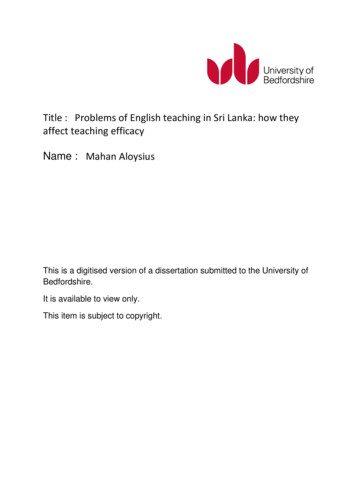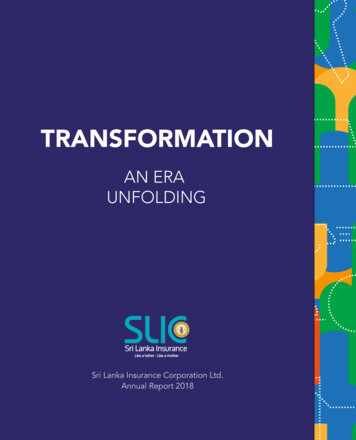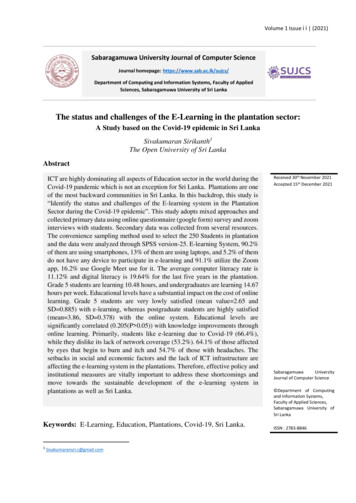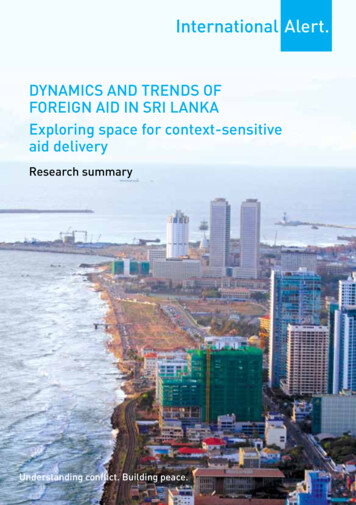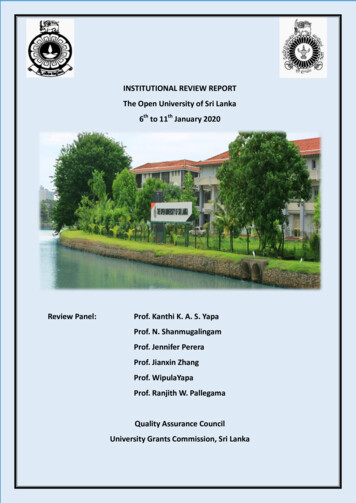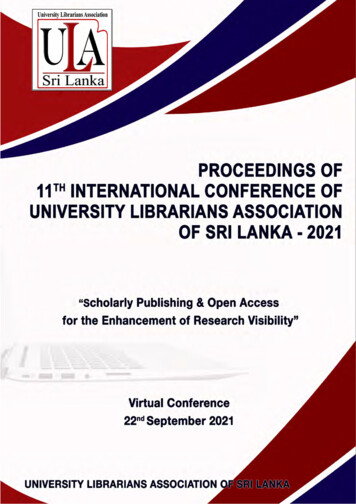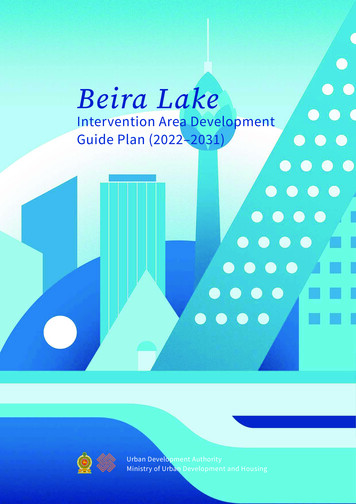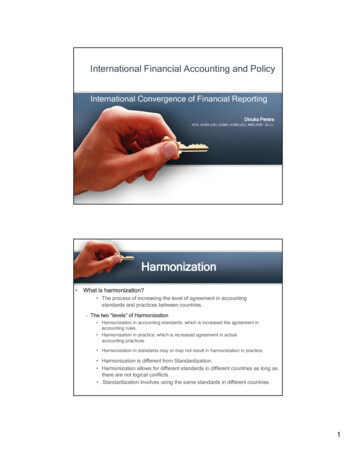
Transcription
International Financial Accounting and PolicyInternational Convergence of Financial ReportingDinuka PereraACA, ACMA (UK), CGMA, ACMA (SL), MBA (PIM - Sri J.)Harmonization What is harmonization? The process of increasing the level of agreement in accountingstandards and practices between countries.– The two “levels” of Harmonization Harmonization in accounting standards, which is increased the agreement inaccounting rules. Harmonization in practice, which is increased agreement in actualaccounting practices. Harmonization in standards may or may not result in harmonization in practice. Harmonization is different from Standardization. Harmonization allows for different standards in different countries as long asthere are not logical conflicts. Standardization involves using the same standards in different countries.1
The Pros and Cons ofHarmonizationPros Expedite the integration of global capital markets and make easier the crosslisting of securities. Facilitate international mergers and acquisitions. Reduce investor uncertainty and the cost of capital. Reduce financial reporting costs. Allow for easy adoption of high-quality standards by developing countries.Cons Significant differences in standards currently exist.The political cost of eliminating differences.Overcoming “Nationalism” and traditions.Will cause “Standards Overload” for some firms at the transition.Diverse standards for diverse places is acceptable.Harmonization EffortsInternational Organization of Securities Commissions (IOSCO) Works to achieve improved market regulation internationally. Works to facilitate cross-border listings. Advocates for the development and adoption of a single-set of high qualityaccounting standards.International Federation of Accountants (IFAC) Works to develop international standards of auditing, ethics, and education. Began International Forum on Accountancy Development (IFAD) to enhancethe accounting profession in emerging countries. Started the Forum of Firms to raise global standards of accounting and auditing.United Nations (UN) / European Union (EU) Has worked to harmonize accounting standards, primarily by way of two directives. Fourth Directive – comprehensive accounting rules on the principle of a “true and fair view.” Seventh Directive – requires consolidated financial statements for company groups ofa certain size.2
Harmonization Efforts - IASBIASB Preceded by the IASC (International Accounting Standards Committee) - IASCwas established in 1973. Works toward harmonization of international accounting standards. Comprised of 14 members (12 full, 2 part-time). Standard development process is open. - Standards are principles-based. Since establishment of IASB, focus is on global standard-setting ratherthan harmonization per se. Comprehensive review of existing IAS (International Accounting Standards). Begun in 1989. - In order to increase consistency of IAS. IASB attempts to follow a Principles-Based approach to standard setting. As such accounting standards are grounded in the the IASB Framework.Principles-Based Approach toAccounting Standard SettingA Principles-Based approach Represents a contrast to a Rules-Based Approach. Attempts to limit additional accounting guidance (e.g., FASB UITFs,FASB Interpretations). Is designed to encourage professional judgment and discourageover-reliance on detailed rules.Support for a Principles-Based Approach from outside the IASB FASB – has published a supportive proposal entitled, “Principles-BasedApproach to U.S. Standard Setting” SEC – has recommended adoption of this approach3
IASB Framework and IFRSsIASB Framework Provides the basis for financial statements presented in accordance with IFRS. Similar to the relationship between U.S. GAAP financial statements andthe FASB Conceptual Framework. Include the objective and underlying assumptions of financial statements. Qualitative characteristics of information. Definition, recognition, and measurement of elements in financial statements. Possesses objective and underlying assumptions of financial statements. Primary objective is to provide information useful to decision making. Underlying assumptions include accrual-basis and going concern.IASB FrameworkQualitative characteristics of information Understandability – should be understandable to people withreasonable financial knowledge. Comparability – allows for meaningful comparisons to financial statementsof previous periods and other companies. Relevance – useful for making predictions and confirming existingexpectations. Reliability – free from bias (neutral) and represents that which it claimsto represent (representational faithfulness).Elements of Financial Statements Definition – assets, liabilities, and other financial statement elementsare defined. Recognition – guidelines as to when to recognize revenues and expenses. Measurement – various bases are allowed, historical cost, currentcost, realizable value, and present value.4
Presentation of Financial Statements(IAS 1)This standard provides guidance in the following areas Purpose of financial statements – to provide decision-useful information. Components of financial statements – balance sheet, statementsof income, cash flows, changes in equity, and notes to thefinancial statements. Fair presentation – the overriding principle of financial statementpresentation. Accounting policies - Should be consistent with all IASB standards. Whenspecific guidance is lacking, use standards on similar issues, anddefinitions of the financial statement elements. Basic principles and assumptions - Reiteration of underlying assumptions- Accrual basis/going concern/comparability. Structure and Content of Financial Statements - Provides informationon presentation format as Current/noncurrent.First Time Adoptions of IFRSs (IFRS 1)IFRS 1 Provides guidance for first time adoption - Much used, particularly in EU. Requires compliance with all effective IFRSs. Allows exemptions when costs deemed to outweigh benefits.Evidence of support for IFRSs Adoption by the EU – public companies in the EU were required tobegin using IFRSs in 2010. IOSCO has endorsed IFRSs for cross-listings. Many developing nations have adopted IFRSs. Some countries disallow IFRSs for domestic firms but allow foreigncompanies to use them. U.S. is a major exception, does not allow use of IFRSs.5
IASB/FASB ConvergenceThe Norwalk Agreement Between the IASB and FASB. To work toward accounting standards convergence.FASB’s key initiatives in the Norwalk Agreement Joint projects – boards will work together to address some issues Short-term convergence – to remove differences between IFRSs andU.S. GAAP for issues where convergence is deemed most likely. IASB liaison – IASB member in residence at FASB. Monitoring IASB projects – FASB monitors IASB projects of most interest. Convergence research project – identification of all major differencesbetween IFRSs and U.S. GAAP. Convergence potential – FASB assesses agenda items for possiblecooperation with IASB.Thank you!6
Harmonization Efforts - IASB IASB Preceded by the IASC (International Accounting Standards Committee) - IASC was established in 1973. Works toward harmonization of international accounting standards. Comprised of 14 members (12 full, 2 part-time). Standard development process is open. - Standards are principles-based.
